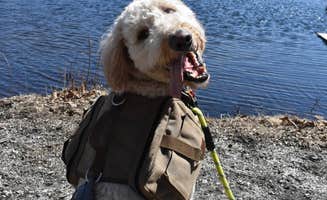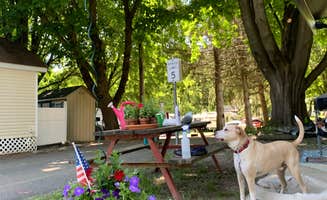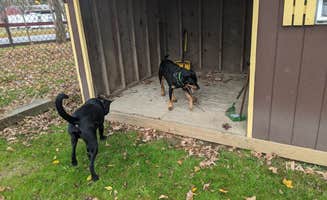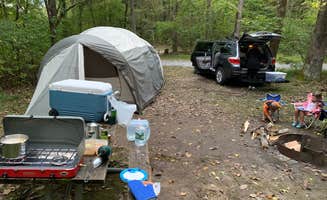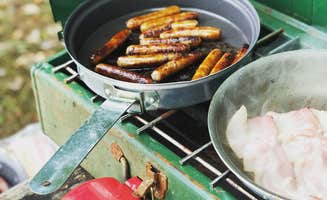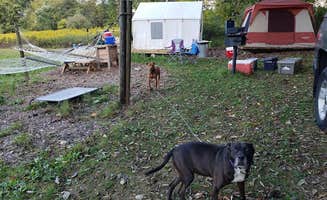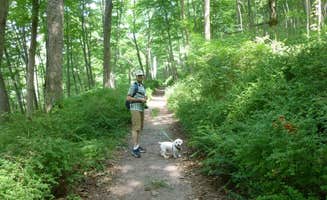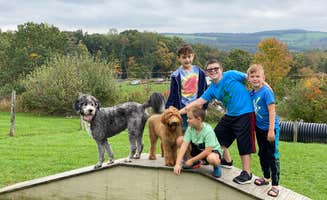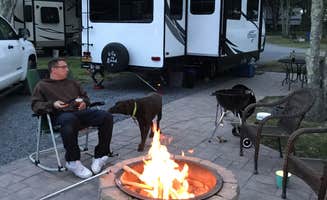Randolph area campgrounds sit within New Jersey's highlands region at elevations between 900-1,200 feet. The area features dense deciduous forests interspersed with glacial lakes and streams. Winter temperatures can drop below freezing from December through March, with summer highs averaging 82°F from June through August.
What to do
Hiking the Appalachian Trail: 9-mile route from Camp Taylor Campground connects to Mt. Tammany for panoramic views. "Hiked to Mt. Tammany from the campsite for the best view in NJ (9 miles round trip)," notes camper Dina S.
Lake activities: free kayak usage at Great Divide Campground provides water recreation during summer months. "Kids had lots of fun on the free kayaks and pool. Staff was friendly and helpful," reports Jojo P.
Wildlife observation: wolf sanctuary tours operate twice daily on weekends from Camp Taylor. "The wolf preserve at the same location was just amazing - we learned so much and could hear the wolves howl from the campsite," explains one visitor.
Primitive camping: 3-6 mile hike required to access backcountry sites at Round Valley. "Located just south of I78 and near the small hamlets of Clinton and Lebanon, what I love most about Round Valley SP is the fact that it has its very own eponymous fresh water reservoir," writes Stuart K.
What campers like
Privacy between sites: wooded separation at several dog friendly campgrounds near Randolph creates natural barriers. At Jenny Jump State Forest, "the camp sites are nicely laid out to ensure privacy. This park is high up on a mountain and affords lovely views," according to Jocelyn G.
Clean facilities: single-stall showers at Stokes State Forest receive consistent praise. "Bathrooms and shower were all single stall and very clean, only a 5 min walk from our site. Two water sources nearby as well," notes E.M.V.
Quiet environment: enforced quiet hours at dog-friendly camping areas like Camp Taylor maintain peaceful atmosphere. "Unlike many other campgrounds we've been to, they are very good about actually enforcing the quiet hours at night, so you can have an actual peaceful and quiet night around the campfire," writes Dan B.
Tent platforms: 12x12 wooden foundations keep gear dry during wet weather. At Stephens State Park Campground, "our site:29 was plenty big enough for a large tent and a hammock. We could have easily fit another large tent," reports Barbara S.
What you should know
Bear activity: proper food storage essential throughout the region's campgrounds. "Three black bears strolled by the campsite next to ours in the early morning — gave us more of an energy boost after a sleepless night than our coffee!" reports Kaitlyn S. from Swartswood State Park.
Alcohol restrictions: policies vary between public and private campgrounds. While state parks typically prohibit alcohol, private facilities like Panther Lake Camping Resort permit responsible consumption.
Firewood regulations: outside wood prohibited at many sites to prevent lantern fly spread. At Camp Taylor, "you have to buy their wood you can't bring any in, they are trying to keep the lantern flies away. $5 bundle for 7 pieces," explains Karralee B.
Road noise: highway sounds audible at certain campgrounds despite forest setting. At Jenny Jump, "my only complaint is that the noise from the highway was quite loud at night," notes one camper.
Tips for camping with families
Swimming options: small lakes with designated areas provide safe recreation for children. "The swimming pond is pleasant and great to cool off in," says Kathy G. about Camp Taylor's facilities.
Playground access: central play areas at several pet-friendly campgrounds near Randolph Township encourage socialization. "It's GREAT for kids. A nice playground with tons of kids running all over," notes a Camp Taylor visitor.
Cabin alternatives: rustic shelters at Stokes State Forest offer family-friendly accommodations during cooler months. "The cabins are reasonably priced and well-appointed, if a bit rustic. The main room has a bunk bed and two twins, a table with benches, two Adirondack chairs, a wood stove set into a fireplace," explains W.L.
Wildlife education: structured programs teach children about local ecology. "The Lakota Wolf Preserve is located on the camp and offers discounted tours for campers," says Jean T.
Tips from RVers
Site leveling: terrain challenges require preparation at most local campgrounds. "We stayed in one of the RV areas across the pond. It was peaceful to hear the frogs chirping at night," notes Julie from Stokes State Forest.
Seasonal considerations: off-peak visits offer more seclusion at popular campgrounds. "We drove through at the end of October and only saw one camper there," observes Laura M. at Stephens State Park.
Water hookups: varying hose distances require planning. "The spots are spacious and campers were spread out throughout the large campground," mentions Jojo P. about Great Divide during their second visit.
Dump station access: typically available near campground exits. "Dump station has a flush hose point. Nice and easy little campground," notes an RVer at Mahlon Dickerson.


